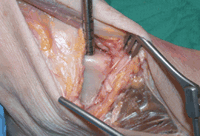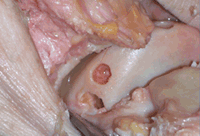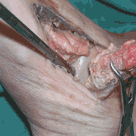Fibular osteotomy provides greater talar exposure for osteochondral transfer
Anterolateral tibial, fibular osteotomies shown to yield the best exposure using ATFL release.
![AOFAS [logo]](/~/media/images/news/print/orthopedics-today/2006/11_november/aofas_150_67_19144.gif) Duke University researchers concluded that the fibular osteotomy approach with takedown of the anterior talofibular and calcaneofibular ligaments, provides the greatest exposure for osteochondral allograft transfers to treat posterolateral osteochondral talar lesions.
Duke University researchers concluded that the fibular osteotomy approach with takedown of the anterior talofibular and calcaneofibular ligaments, provides the greatest exposure for osteochondral allograft transfers to treat posterolateral osteochondral talar lesions.
An anterolateral tibial osteotomy was a good alternative, based on results of their cadaveric study into five possible approaches for treating this type of ankle cartilage lesion.
Exposure is critical for success of an osteochondral allograft transfer. “You need perpendicular access to the lesion,” said James R. Santangelo, MD, a foot and ankle fellow at Duke University Medical Center, Durham, N.C.
|
He led the study, done with three other orthopedic surgeons, and presented results at the American Orthopaedic Foot and Ankle Society’s annual summer meeting.
Surgical guidance
Santangelo told Orthopedics Today the results would help answer questions about advantages of the different types of exposure to the posterolateral talar dome.
Although surgeons may have the greatest experience with fibular osteotomy, “there are not many guidelines in the literature noting the location of the osteotomy, or the need for ligament release. Nor is the incidence of nonunion documented. The fibular osteotomy does carry some morbidity with the potential for nonunion.”
The investigators used eight cadaver ankles to study five different surgical exposures to the talus for osteochondral allograft transfers. Two ankles were dissected in a pilot study to determine the sequence of approaches.
Five exposures
They used the following sequence for each specimen:
(1) anterolateral arthrotomy with anterior talofibular ligament (ATFL) release;
(2) anterolateral tibial osteotomy;
(3) fibular osteotomy with ATFL intact;
(4) fibular osteotomy with ATFL release; and
(5) fibular osteotomy with ATFL and calcaneofibular ligament (CFL) release.
In each case, researchers used a 6-mm osteochondral allograft transfer (OATS) instrument to harvest an osteochondral plug from the posterolateral part of the talar dome. They then measured the distance from the anterior talar articular surface to the posterior edge of the recipient site with a flexible ruler.
Surgeons obtained the greatest anterior posterior (AP) exposure with approach #5, fibular osteotomy with ATFL/CFL release, which averaged 46.6 mm or 94.6% of the talar dome’s AP dimension, vs. anterolateral arthrotomy with ATFL takedown, which provided the least exposure (21.2 mm. 43.3% of talar dome). Exposure #4, fibular osteotomy with ATFL release, provided the next greatest exposure (44.9 mm, 91.2% of talar dome).
“Our data were very consistent across all specimens,” said Santangelo. The necessity for osteotomy is relatively infrequent when treating talar osteochondral lesions. He may consider using the anterolateral tibial osteotomy more often. “We noticed that [it] is a versatile alternative to the fibular osteotomy.”
A recent study by Muir et al in the American Journal of Sports Medicine reinforced Santangelo’s conclusions concerning approaches involving anterolateral arthrotomy, anterolateral tibial osteotomy and fibular osteotomy for posterolateral osteochondral talar lesions, he said.
|
|
Images: Santangelo JR |
For more information:
- Muir D, Saltzman CL, Tochigi Y, Amendola, N. Talar dome access for osteochondral lesions. Am J Sports Med. 2006; 34:1457-1463.
- Santangelo JR, Garas D, Wang D, Easley ME. Comparison of surgical approaches to posterolateral osteochondral lesions of the talus. Presented at the American Orthopaedic Foot and Ankle Society 22nd Annual Summer Meeting. July 14-16, 2006. La Jolla, Calif.

![James R. Santangelo, MD [photo]](/~/media/images/news/print/orthopedics-today/2006/11_november/santangelo_70_90_19144.jpg)


